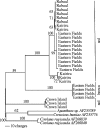Episymbiotic microbes as food and defence for marine isopods: unique symbioses in a hostile environment
- PMID: 16024384
- PMCID: PMC1564109
- DOI: 10.1098/rspb.2005.3082
Episymbiotic microbes as food and defence for marine isopods: unique symbioses in a hostile environment
Abstract
Symbioses profoundly affect the diversity of life, often through novel biochemical services that symbionts provide to their hosts. These biochemical services are typically nutritional enhancements and less commonly defensive, but rarely both simultaneously. On the coral reefs of Papua New Guinea, we discovered unique associations between marine isopod crustaceans (Santia spp.) and episymbiotic microbes. Transmission electron microscopy and pigment analyses show that episymbiont biomass is dominated by large (20-30 microm) cyanobacterial cells. The isopods consume these photosymbionts and "cultivate" them by inhabiting exposed sunlit substrates, a behaviour made possible by symbionts' production of a chemical defence that is repulsive to fishes. Molecular phylogenetic analyses demonstrated that the symbiotic microbial communities are diverse and probably dominated in terms of population size by bacteria and small unicellular Synechococcus-type cyanobacteria. Although largely unknown in the oceans, defensive symbioses probably promote marine biodiversity by allowing niche expansions into otherwise hostile environments.
Figures





Similar articles
-
Ultrastructure, molecular phylogenetics, and chlorophyll a content of novel cyanobacterial symbionts in temperate sponges.Microb Ecol. 2012 Oct;64(3):771-83. doi: 10.1007/s00248-012-0047-5. Epub 2012 Apr 19. Microb Ecol. 2012. PMID: 22526400
-
The biogeography and phylogeny of unicellular cyanobacterial symbionts in sponges from Australia and the Mediterranean.Microb Ecol. 2004 Aug;48(2):167-77. doi: 10.1007/s00248-003-1062-3. Epub 2004 Jun 3. Microb Ecol. 2004. PMID: 15546037
-
Bacterial symbionts in the hepatopancreas of isopods: diversity and environmental transmission.FEMS Microbiol Ecol. 2007 Jul;61(1):141-52. doi: 10.1111/j.1574-6941.2007.00329.x. Epub 2007 May 16. FEMS Microbiol Ecol. 2007. PMID: 17506824
-
Diversity, Genomics, and Distribution of Phytoplankton-Cyanobacterium Single-Cell Symbiotic Associations.Annu Rev Microbiol. 2019 Sep 8;73:435-456. doi: 10.1146/annurev-micro-090817-062650. Annu Rev Microbiol. 2019. PMID: 31500535 Review.
-
Coral-the world's most diverse symbiotic ecosystem.Mol Ecol. 2015 Nov;24(21):5330-47. doi: 10.1111/mec.13400. Epub 2015 Oct 21. Mol Ecol. 2015. PMID: 26414414 Review.
Cited by
-
The second skin: ecological role of epibiotic biofilms on marine organisms.Front Microbiol. 2012 Aug 23;3:292. doi: 10.3389/fmicb.2012.00292. eCollection 2012. Front Microbiol. 2012. PMID: 22936927 Free PMC article.
-
DNA variation and symbiotic associations in phenotypically diverse sea urchin Strongylocentrotus intermedius.Proc Natl Acad Sci U S A. 2008 Oct 21;105(42):16218-23. doi: 10.1073/pnas.0807860105. Epub 2008 Oct 13. Proc Natl Acad Sci U S A. 2008. PMID: 18852450 Free PMC article.
-
Water temperature and disease alters bacterial diversity and cultivability from American lobster (Homarus americanus) shells.iScience. 2023 Apr 8;26(5):106606. doi: 10.1016/j.isci.2023.106606. eCollection 2023 May 19. iScience. 2023. PMID: 37128602 Free PMC article.
-
Antagonistic interactions mediated by marine bacteria: the role of small molecules.J Chem Ecol. 2013 Jul;39(7):879-91. doi: 10.1007/s10886-013-0316-x. Epub 2013 Jul 14. J Chem Ecol. 2013. PMID: 23852047 Review.
-
Can a Symbiont (Also) Be Food?Front Microbiol. 2019 Nov 7;10:2539. doi: 10.3389/fmicb.2019.02539. eCollection 2019. Front Microbiol. 2019. PMID: 31787946 Free PMC article. No abstract available.
References
-
- Barber P.H, Palumbi S.R, Erdmann M.V, Moosa M.K. Sharp genetic breaks among populations of Haptosquilla pulchella (Stomatopoda) indicate limits to larval transport: patterns, causes, and consequences. Mol. Ecol. 2002;11:659–674. - PubMed
-
- Blunt J.W, Munro M.H.G. Marine Chemistry Group, Department of Chemistry, University of Canterbury; Christchurch, New Zealand: 2003. MarinLit: a database on the literature on marine natural products.
-
- Blunt J.W, Copp B.R, Munro M.H.G, Northcote P.T, Prinsep M.R. Marine natural products. Nat. Prod. Rep. 2003;20:1–48. (and previous NPR reviews by Faulkner D. J. cited therein) - PubMed
-
- Brooks W.R. The influence of the location and abundance of the sea anemone Calliactis tricolor (Le Sueur) in protecting hermit crabs from octopus predators. J. Exp. Mar. Biol. Ecol. 1988;116:15–21.
Publication types
MeSH terms
Substances
LinkOut - more resources
Full Text Sources
Miscellaneous

